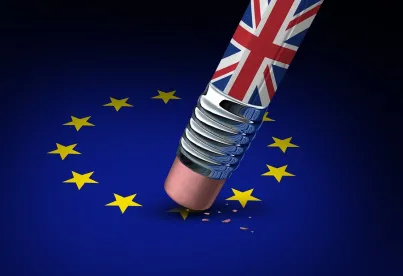The third round of the Brexit negotiations, at the end of August, was not very productive. This was despite the British side’s publication of an impressive number of position papers over the course of the summer. These covered various technical questions but also the sensitive issue of the participation in the customs union and how to avoid reestablishing a border between Northern Ireland and the Republic of Ireland.
The documents were not well received by the EU side, not only because a number of them anticipated negotiations on the future relationship, but mainly because they brought no realistic solutions. Rather, they confirmed the EU’s view that there was no real leadership on Brexit in London and that the negotiators were constrained by an official position that had become unrealistic: that the UK could, with no harm, leave the customs union and the internal market as soon as by the end of the two years foreseen by Article 50 of the EU Treaty.
In view of the impasse, the EU therefore asked for a postponement of the fourth round of talks scheduled for the week of 18 September. The talks were indeed postponed for a week.
A Softening in the UK’s Position
In the interim, in an attempt to break the deadlock, Prime minister Theresa May, in a speech in Florence on September 22, presented a revised UK position aimed at relaunching the negotiations on a better footing.
The most important novelty in the Prime Minister’s “Florence speech” related to the transition period, aimed at bridging the gap between the UK withdrawal in March 2019 and the beginning of a new trade relationship. Theresa May suggested in her speech that this period should last “around two years,” in order for the UK and the EU to be able to “implement smoothly” the new arrangements concluded. Importantly, she accepted that, during that period, market access “should continue on current terms” and that the framework would be “the current structure of EU rules and regulations”. This means that, contrary to the UK’s former position, during that period it would remain in the EU internal market and customs union, and would respect the principle of free movement of people as well as the jurisdiction of the Court of Justice of the EU (“CJEU”).
A few days after the Florence speech, on 26 September, the president of the European Council Donald Tusk travelled to London to discuss the way ahead. After his talks, he said that he felt “cautiously optimistic about the constructive and more realistic tone of the prime minister’s speech in Florence and of our discussion”, adding that the speech indicated that “this philosophy of having a cake and eating it is finally coming to an end”.
Nevertheless, the fourth round of negotiations, held in the last week of September, saw little concrete progress on the “separation” issues currently under discussion – citizens’ rights, the Irish Border, and the UK’s financial settlement (the “exit bill”).
All attention then turned to the Conservative Party Conference, which took place in London on October 1 to 4. Discussions at Conference in London confirmed that the Cabinet remains divided on Brexit. Notably, the Foreign Secretary, Boris Johnson, in a newspaper column, expressed positions much harder than those outlined by the Prime Minister. However, amid speculation that he was about to mount a leadership challenge on the Prime Minister – an attempt that was seen as having failed – the Foreign Secretary rowed his comments back somewhat towards the Prime Minister’s softened line.
There was minimal progress during the fifth round of negotiations, which took place on October 9 to 12.
Changing Views on a “No Deal” Brexit
At the start of the negotiation process, the view in Brussels had been that there as a significant risk that the UK would “crash out” of the EU without a deal – either by choice, or simply because the negotiations would not succeed in the time available, and given the divergent positions either side of the English Channel. (For further analysis on this scenario, also known as the “cliff edge” scenario, see Sir Michael Leigh’s blog post, here.) This view was reinforced by the Prime Minister’s statement, in her Lancaster House speech of January 17, 2017, that “no deal is better than a bad deal” for the UK.
At the plenary session of the European Committee of the Regions on October 10, however, European Council President Donald Tusk stated that the EU is not at present anticipating a “no deal” scenario. In so doing, Mr. Tusk was seen to be responding to the UK’s reported threats, over the summer, to walk out of the talks if presented with a significant “exit bill”. This reflects a broader shift in attitude in Brussels: there is now a sense that, so long as the UK presents a reasonable methodology for calculating the financial settlement, it is likely that a “no deal” scenario can be avoided.
The mood in the UK, on the other hand, is now rather worse. Some reports put the proportion of Cabinet members believing that no agreement will be reached between 40 and 50 per cent. Similarly, in the Department for Exiting the EU, which keeps shedding significant numbers of staff, and both morale and optimism on a deal are said to be very low.
The tensions that lie behind this pessimism have surfaced, for example, in a fight within the Conservative Party on whether funds should be set aside to plan for a “no deal” Brexit. The UK Chancellor, Philip Hammond – seen as a leader of the “soft Brexit” camp and a pragmatist – was attacked by “hard Brexiteers” for refusing to set aside funds to plan for a “no deal” scenario. Despite this refusal, a Brexit white paper on customs released by the UK government on October 9 outlined various contingency measures to cope with such an eventuality; and on October 25, the Chief Executive of the UK customs agency told Parliament that his department would require up to £450 million in extra funding, should it need to cope with a “no deal” Brexit.
Progress to Date on the “Separation Issues”
The current state of play of the various issues currently under discussion is as follows:
- On citizens’ rights:
- The assurance given by the Prime Minister that the agreement will be transferred directly into UK law was well received in Brussels, where the continuing “direct effect” of EU law is considered essential. However, work still needs to be done to ensure that the interpretation of these rights is consistent between the EU and the UK – and in particular whether a court or tribunal could replace the jurisdiction of the CJEU.
- These discussions suffered a blow when a draft position paper from the British Home Office (the Interior Ministry) was leaked in August. This early draft contained helpful words on EU citizens’ rights during any standstill period (after the UK formally leaves the EU in May 2019, but before a trade deal is agreed). However, it also suggested that higher- and lower-skilled EU workers would be treated differently in the UK after Brexit. This did not please countries in Central and Eastern Europe, from where most EU migrants in lower-skilled UK jobs originate.
- The UK and the EU also disagree on family reunification rights, and the ability to carry social security rights built up in one Member State to another post-Brexit.
- Following damaging coverage of EU 27 citizens lawfully resident in the UK being mistakenly issued “notice to leave” letters by the Home Office, the UK notified the EU of its plans to implement a simplified procedure enabling enforcement of citizens’ rights. The EU will now study the practicalities of this procedure.
- There was slight progress on the issue of the border between Northern Ireland and the Republic of Ireland.
- The negotiations moved forward on the joint principles for the continuation of the Common Travel Area. During the latest round, the negotiators agreed that the six principles proposed by the EU in September would direct their work to protect the Good Friday Agreement that brought peace to Ireland.
- However, the EU negotiators rejected as unrealistic the UK’s August 15 “Future Partnership Paper” on customs. This document implied that, in order to square the circle of leaving the EU customs union without imposing new border controls, a new, separate customs union be established between the EU and the UK, after the UK has left the existing one.
- The difficulties, in this respect, are a consequence of three conflicting commitments of the UK government. First, it has interpreted the 2016 vote to leave the EU as requiring that the UK leave the customs union as well. This is necessary, if the UK is to negotiate its own trade deals with third countries. Second, and conversely, it has ruled out installing a “hard” (customs) border between Northern Ireland and the Republic of Ireland. This is a political necessity, as such checks could lead to a breakdown of the Good Friday Agreement. Third, the UK’s minority Conservative government is supported by the Democratic Unionist Party, which has ruled out any solution that would require border checks between Northern Ireland and the rest of the UK – such as leaving Northern Ireland in the EU customs union, and checking any goods that are shipped across the Irish sea, whether from Northern Ireland or the Republic. This is a core political position for the Unionists, whose voters could see any such arrangement as foreshadowing a unification of the island of Ireland. Although the UK can secure any two of these objectives, it is difficult to see how it can achieve all three.
- As to the financial settlement, the EU side was pleased to hear that, after the Florence Speech, the UK now accepts that it will continue to contribute to the EU budget until the end of the current Multiannual Financial Framework (“MFF”) in 2021 (corresponding to the two years of the transition period proposed by Theresa May). However, the EU negotiators were puzzled by the official UK position that there is no “legal” obligation for the UK to contribute further, and still await a clear position paper from London on the “methodology” to calculate the obligations. This will probably not come any time soon, due to the sensitivity of the issue in the UK’s domestic politics. Indeed, during the fifth round of negotiations, the UK again declined to spell out its financial commitments to the EU post-Brexit. Michel Barnier therefore stated that this issue had reached a state of deadlock that he described as “disturbing.”
- One agreement was however reached between the EU and the UK in the Brexit negotiations: a deal about the division of current quota arrangements with third countries agreed in WTO for certain agricultural products. The principle agreed is that the cumulative quotas offered by the EU and the UK will remain as they are, with the UK taking over a part of the current EU quotas corresponding to its consumption of those quotas over the last three years. The idea is that third countries would not result “worse off” after Brexit. However, those third countries must agree to this deal – and seven of the world’s biggest food exporters (the U.S., Brazil, Argentina, Canada, New Zealand, Uruguay and Thailand) formally rejected the deal in a letter dated September 26.
No “Sufficient Progress” to Open Talks on a Trade Deal
In this context, the UK still hoped that the EU would open the second phase of the Brexit talks, on the future UK-EU trade relationship. This hope has been dashed.
On October 3, the European Parliament in Strasburg adopted by 557 to 92 (with 29 abstentions) a Resolution, drawn up by the five major political groups, stating that “sufficient progress” has not been made to allow negotiations on the UK’s future relationship with the EU to begin. This was in line with what the president of the Commission Jean Claude Juncker and the EU negotiator Michel Barnier had said in the introductory debate.
After the fifth round of negotiations, Mr. Barnier was unable to recommend that the October 19 to 20 European Council open discussions with the UK on the future relationship, and the European Council agreed. That decision will now be postponed until the regular meeting of the European Council in December.. Mr. Barnier also confirmed that he will arrange for meetings with David Davis, the UK’s Secretary for State for Exiting the EU, before year’s end.
As a good will gesture, however, the Conclusions of the European Council contain one new element: the EU 27 will start “preparatory discussions” on “the framework for the future relationship and on possible transitional arrangements”. These discussions will take place at 27, but it is clear that there will be a lot of spin from London. It is thus a sort of “concession” made to the British request to open talks on the future, while respecting the principle that formal negotiations can only start when there is “sufficient progress” on the three elements of the withdrawal treaty. On the other hand, the 27 expect that this internal reflection will also help make more clear in the coming weeks where the EU’s red lines are.
December is now seen as a “make or break” point for these talks. Mr. Barnier has stated that there is significant political will in the EU to reach “sufficient progress.” It is in the UK’s economic interest to do so – not least as a number of financial sector and manufacturing businesses are understood to have made it clear to the UK government that they cannot wait much longer before they activate contingency plans for a “no deal” Brexit. On the other hand, the view in Brussels is that, if progress on the talks is such that “sufficient progress” cannot be reached in December, then the talks are more likely than not to fail – and, as Donald Tusk put it in his Committee of the Regions speech, “we will have to think about where we are heading.”






 />i
/>i
